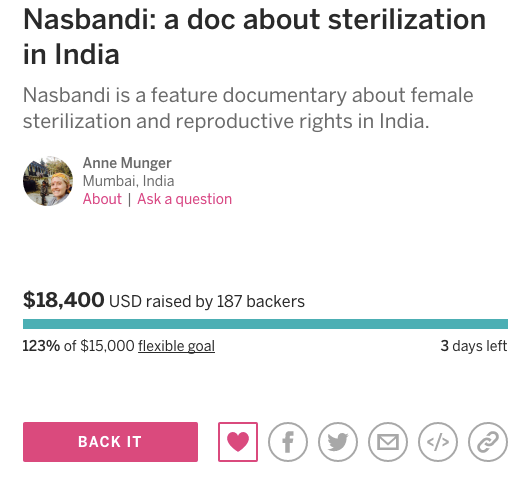I am making a documentary. In India. And I have zero money. And I mean really zero -- I work at a small NGO in one of the most expensive cities in the whole world (London).
So when this spring, my film partner, Anne Munger and I took account of our funding options for our film, we came to a scary conclusion: crowdfunding was our best bet. Because so many film grants require footage we were left in a chicken and egg quandary. We needed money to get footage but we needed footage to get money. Crowdfunding allowed us to sidestep that problem.
Because we also wanted to engage a community early on, crowdfunding also made sense. The film is about India’s family planning policies. Specifically we want to follow both the policy debate around these issues and the women they most affect. Our ultimate aim with this film (read more about it here) is to engage a larger audience around these complex issues, so we want to engage that audience right from the start. We want to find the passionate advocates, the sympathetic supporters, the curious citizens and engage them!
This led us to the conclusion: crowdfunding was the ticket. The only problem? Crowdfunding is hard. People often underestimate it. Just throw together an attractive page and people will send you money, right? Wrong. People don’t give money to just anything.
Several months later and three days from the end of our campaign (!!!!) we have successfully raised $18,400 of our goal of $15,000. We are now hoping to raise $20,000 by the end but we are already extremely pleased with the results.

Here are a few of the lessons we learned from the process.
1. The importance of a healthy network.
We are blessed with a robust network of amazing friends, families, coworkers and acquaintances. Networking often has a dirty, transactional connotation. But what I’ve learned is some of our biggest supporters throughout this process have been the amazing people we’ve met and kept in touch with. Having a network is often just the product of keeping in touch with friends. These friends were eager to help when the time came. They’d known that we’ve been working on a documentary, that this is our passion and they wanted us to succeed. Even people we were not necessarily close with stepped forward when the time came and really showed their support. I think this was key to success (not to mention an extremely touching byproduct).
2. Assembling a strong “team”
Before we launched we recruited about ten close friends each to be on our fundraising team. These people agreed to send the campaign to five to ten of their friends who we didn’t know. We approached these people about a month before launch and then again right before launch so they were pumped up and ready to go. These people let us break into our second degree network.
3. Securing Pre-Committed Funds
We had read in our research that campaigns that it is critical to reach 30% of your fundraising goal in the first week. We decided to make this a certainty by approaching a small group of more significant donors before launching. We secured this funding before launch and asked them to make the first contributions right as the campaign launched. This early momentum reassured less committed supporters. Thanks to this early advantage, we hit $10,000 within the first three days! With only $5,000 left to go over the remaining 19 days we knew we could achieve our goal and we even started planning a stretch goal for when we hit 15.
4. A Dynamic Pitch Video
The actual text and video for the campaign was something we thought a lot about. Videos are crucial for a successful crowdfunding campaign, especially for a film project. Because we were building on a short film we made in 2014, we already had some footage from India. We used this footage along with footage of ourselves talking to camera explaining our journey with this project, what it was about and why we were qualified to tackle this subject. We tried to make it inspirational rather than depressing. The issues surrounding reproductive rights in India are serious, yes, but we can do something about them! We wanted these early supporter to be our first step towards community engagement and we wanted them energized.
5. Fun, Thoughtful (and Cheap!) Perks
We had heard from other filmmakers that a significant amount of the funds they raised ended up being used up on perks they’d promised. Merchandise can be expensive. So we decided to stick to free and low cost perks. We brainstormed to come up with perks that we could deliver on with minimal costs but would still be exciting to our audience. These ranged from a link to our previous short doc to a google chat with us and some of the women we’d be working with while in India!
6. Posting Regular Updates
As the campaign got going we kept in touch with our supporters through regular updates on the campaign page and on social media. We used the perk of “twitter shout outs” as an opportunity to build a buzz around the campaign. We posted all our articles and achievements on Facebook. We recorded a new silly video once we hit $15,000 to thank everyone and announce our stretch goal. This kept our audience engaged and excited, they all joined our team as we went.
6. Working with the Media
To reach a wider audience beyond our immediate networks we decided to publish several articles about our film and the topic during the campaign (HI WORLD!). Before launching we wrote a piece about our journey for Huffington Post. On launch day we wrote a blog for LSE’s South Asia Centre about one of the central things we want to examine in the film. Because I studied at LSE this was part of my extended network. Through this piece we had several different people reach out to us and offer assistance. From access to rare archives in the LSE library to fundraising help, the article definitely helped to boost our visibility beyond our immediate network.
In a crazy coincidence a ruling came down from India’s Supreme Court during the campaign that directly related to our film. We jumped on the opportunity and published an article about it. Finally, a blog post ended up featuring our campaign as well which provided external legitimacy! This was luck and in large part, again, due to our early success.
The end result
Before launch day we lost sleep, we ran calculations, we worried. A lot. Then came the day. We had our close friends and family put in the pre-committed money and we began a long day of blasting out emails to everyone we’d ever met who might be interested in the project.
The first 24 hours of the campaign were madness. Writing and responding to emails, checking the ticker on the side of the campaign. It was a lot of work but it went well and we couldn’t be more thrilled. This was the initial push we needed to get our documentary going. Later, of course, we will require more funds for post production but by then we will have footage to make our grant applications stronger. And we will already have a community of almost 200 supporters behind us! You can check out our campaign and what we did here!
